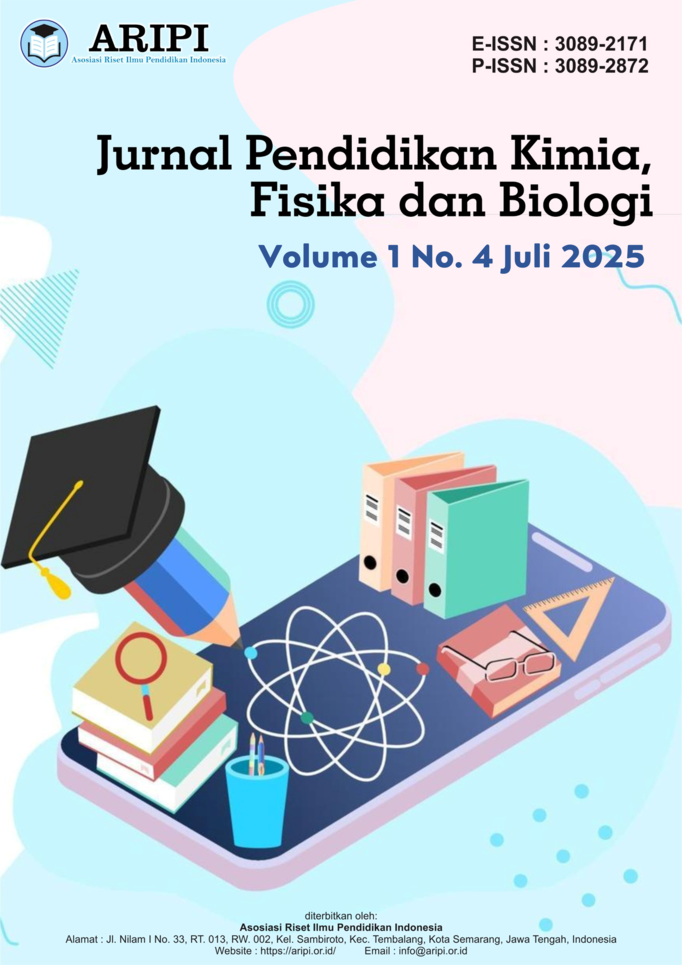Pembuatan Nano Kitosan dengan Metode Gelasi Ionik Menggunakan SEM (Scanning Elektron Microscopy)
DOI:
https://doi.org/10.61132/jupenkifb.v1i4.344Keywords:
Chitosan, Ionic Gelation, NaTTP, SEM (Scanning Elektron Microscopy)Abstract
This study aims to determine how nano chitosan is produced through the ionic gelation method. The process of making nano chitosan is carried out using variations in chitosan concentrations of 1%, 5%, and 10%, and using a magnetic stirrer. Morphological tests were carried out using Scanning Electron Microscopy (SEM) to observe the shape and size of the particles formed. The addition of TPP (Trisodium Tripolyphosphate) as a crosslinker and certain surfactants are used to increase particle stability. Treatment for ±2 hours showed optimal results in terms of a more homogeneous particle size distribution. Based on the results of SEM observations, it is known that increasing the concentration and time settings and the use of appropriate surfactants can reduce wrinkles in nano chitosan particles. The particle size obtained is in the range of 278–350 nm. Thus, the ionic gelation method has proven effective in producing uniform nano chitosan and has good morphology for further applications.
References
Agusnar, H., Chairuddin, & Hannani, N. (2019). Pembuatan kitosan perak sebagai adsorben untuk menurunkan kadar logam besi (Fe) dan zink (Zn) pada air sungai Desa Kopas Kecamatan Simpang Empat Kabupaten Asahan. Abdimas Talenta: Jurnal Pengabdian Kepada Masyarakat, 3(2), 383–392. https://doi.org/10.32734/abdimastalenta.v3i2.4161
Agustina, I., Sutresna, G., & Widodo, T. W. (2015). Isolasi kitin, karakterisasi, dan sintesis kitosan dari kulit udang. Jurnal Kimia, 9(2), 271–278.
Handayani, L., Syahputra, F., & Astuti, Y. (2018). Utilization and characterization of oyster shell as chitosan and nanochitosan. Jurnal Kimia Sains dan Aplikasi, 21(4), 224–231. https://doi.org/10.14710/jksa.21.4.224-231
Hartati Sari. (2021). Pembuatan nano kitosan menggunakan metode gelasi ionik dengan proses bottom-up dari cangkang kerang darah (Anadara granosa) [Skripsi, Universitas Muhammadiyah Purwokerto].
Letahiit, S. B., Nindatu, M., Seumahu, C. A., & Riry, J. (2022). Effect of NPK fertilizer and chitosan on growth and production of green mustard (Brassica juncea L). Agrologia, 11(1), 67. https://doi.org/10.30598/ajibt.v11i1.1544
Muhamad, L., Nadia, H., & Huli, L. O. (2018). Pembuatan dan karakterisasi kitosan dari cangkang rajungan (Portunus pelagicus) asal Sulawesi Tenggara. Jurnal Fish Protech, 1(2), 77–84.
Qonitaninnsa, S., Fadli, A., & Sunarno. (2020). Sintesis nano kitosan dengan metode gelasi ionik menggunakan pelarut asam asetat dengan variasi konsentrasi kitosan. JOM FTEKNIK, 7(2).
Safrina, H. D., Setyowati, D. L., & Nur, A. (2022). Antimicrobial activity of nanochitosan shrimp shell as a hand sanitizer. Journal of Marine and Coastal Science, 11(1). https://e-journal.unair.ac.id/JMCS
Sahdiah, H., & Kurniawan, R. (2023). Optimasi tegangan akselerasi pada Scanning Electron Microscope – Energy Dispersive X-Ray Spectroscopy (SEM-EDX) untuk pengamatan morfologi sampel biologi. Jurnal Sains dan Edukasi Sains, 6(2), 117–123. https://doi.org/10.24246/juses.v6i2p117-123
Sulistyo, R., Lestari, D., Irawanto, D., Wardana, L. A., & Muhammad, F. (2020). Sebagai matrik pupuk urea. Jurnal Integrasi Proses, 9(2), 27–33. http://jurnal.untirta.ac.id/index.php/jip
Downloads
Published
How to Cite
Issue
Section
License
Copyright (c) 2025 Jurnal Pendidikan Kimia, Fisika dan Biologi

This work is licensed under a Creative Commons Attribution-ShareAlike 4.0 International License.





